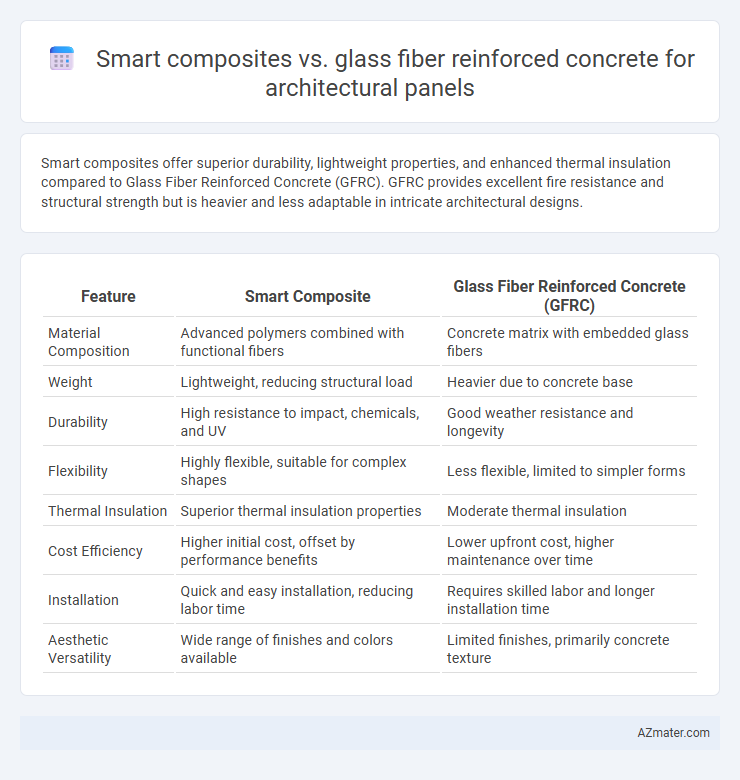Smart composites offer superior durability, lightweight properties, and enhanced thermal insulation compared to Glass Fiber Reinforced Concrete (GFRC). GFRC provides excellent fire resistance and structural strength but is heavier and less adaptable in intricate architectural designs.
Table of Comparison
| Feature | Smart Composite | Glass Fiber Reinforced Concrete (GFRC) |
|---|---|---|
| Material Composition | Advanced polymers combined with functional fibers | Concrete matrix with embedded glass fibers |
| Weight | Lightweight, reducing structural load | Heavier due to concrete base |
| Durability | High resistance to impact, chemicals, and UV | Good weather resistance and longevity |
| Flexibility | Highly flexible, suitable for complex shapes | Less flexible, limited to simpler forms |
| Thermal Insulation | Superior thermal insulation properties | Moderate thermal insulation |
| Cost Efficiency | Higher initial cost, offset by performance benefits | Lower upfront cost, higher maintenance over time |
| Installation | Quick and easy installation, reducing labor time | Requires skilled labor and longer installation time |
| Aesthetic Versatility | Wide range of finishes and colors available | Limited finishes, primarily concrete texture |
Introduction to Advanced Architectural Panels
Smart composites enhance architectural panels by integrating multifunctional materials that offer adaptive responses to environmental changes and improved durability. Glass fiber reinforced concrete (GFRC) provides high tensile strength, lightweight properties, and superior resistance to cracking, making it an ideal choice for intricate architectural designs. Combining smart composites with GFRC can lead to innovative panels that deliver both aesthetic versatility and structural performance for modern architectural applications.
Overview of Smart Composite Materials
Smart composite materials for architectural panels combine advanced fibers and resins to offer enhanced strength, durability, and adaptability compared to traditional Glass Fiber Reinforced Concrete (GFRC). These composites integrate sensors or responsive elements that enable self-healing, environmental sensing, or shape-changing capabilities, elevating their functional performance in dynamic architectural applications. The innovation in smart composites results in reduced maintenance costs, improved structural health monitoring, and expanded design flexibility beyond the static nature of GFRC panels.
Fundamentals of Glass Fiber Reinforced Concrete (GFRC)
Glass Fiber Reinforced Concrete (GFRC) is a composite material consisting of a cementitious matrix embedded with alkali-resistant glass fibers, providing enhanced tensile strength, flexibility, and durability compared to conventional concrete. Its lightweight nature, fire resistance, and high impact tolerance make GFRC an ideal choice for architectural panels requiring intricate designs and long-term performance. Smart composites, while offering adaptive properties through embedded sensors or responsive materials, generally do not match the proven structural reliability and cost-effectiveness of GFRC in architectural applications.
Mechanical Properties Comparison
Smart composites for architectural panels exhibit superior tensile strength and impact resistance compared to Glass Fiber Reinforced Concrete (GFRC), which offers robust compressive strength but lower flexibility. The smart composite materials typically incorporate advanced polymers and nano-enhancements, resulting in higher durability and improved fatigue performance under dynamic loads. GFRC panels excel in fire resistance and thermal stability, yet smart composites provide better crack resistance and lighter weight, making them more advantageous for complex architectural designs demanding mechanical versatility.
Weight and Structural Efficiency
Smart composite architectural panels offer superior structural efficiency with significantly reduced weight compared to glass fiber reinforced concrete (GFRC), making them ideal for lightweight facade applications. The high strength-to-weight ratio of smart composites allows for thinner, lighter panels without compromising durability or load-bearing capacity. In contrast, GFRC panels tend to be heavier, which increases installation complexity and structural support requirements.
Durability and Weather Resistance
Smart composites offer superior durability and weather resistance compared to glass fiber reinforced concrete (GFRC) for architectural panels, thanks to advanced polymer matrices that resist moisture, UV radiation, and thermal expansion. GFRC, while strong and lightweight, tends to absorb water and degrade under freeze-thaw cycles, leading to surface cracking and reduced longevity. Smart composites maintain structural integrity and aesthetic quality over extended periods in harsh environmental conditions, making them ideal for long-term exterior applications.
Design Versatility and Aesthetics
Smart composite materials offer superior design versatility compared to glass fiber reinforced concrete (GFRC), enabling intricate shapes and complex geometries with ease. Their lightweight nature and customizable surface finishes provide architects with enhanced aesthetic options, including high-definition textures and vibrant colors. GFRC panels, while strong and durable, have more limited design flexibility and typically present a uniform, concrete-like appearance that restricts creative architectural expression.
Sustainability and Environmental Impact
Smart composite panels exhibit superior sustainability compared to Glass Fiber Reinforced Concrete (GFRC) due to their lower carbon footprint and enhanced recyclability, reducing environmental impact throughout the lifecycle. GFRC, while durable, involves energy-intensive cement production and less efficient end-of-life recycling processes that contribute to higher greenhouse gas emissions. Smart composites utilize advanced materials and manufacturing techniques that optimize resource efficiency and promote circular economy principles in architectural applications.
Cost Analysis and Lifecycle Economics
Smart composites for architectural panels offer superior durability and reduced maintenance costs compared to glass fiber reinforced concrete (GFRC), despite a higher initial investment. GFRC panels typically have lower upfront costs but may require more frequent repairs and replacements, increasing long-term expenses. Lifecycle economics reveal that smart composites deliver better return on investment through enhanced longevity, energy efficiency, and minimal repair interventions over typical project spans.
Applications and Future Trends in Architectural Facades
Smart composites in architectural panels offer enhanced durability, self-sensing capabilities, and adaptive responses to environmental changes, making them ideal for innovative facade designs that require dynamic performance. Glass fiber reinforced concrete (GFRC) remains popular for facades due to its high strength-to-weight ratio, weather resistance, and versatility in achieving intricate textures and shapes. Future trends point towards integrating smart composite materials with GFRC to create hybrid panels that combine structural efficiency, energy-saving properties, and aesthetic flexibility for sustainable building envelopes.

Infographic: Smart composite vs Glass fiber reinforced concrete for Architectural panel
 azmater.com
azmater.com